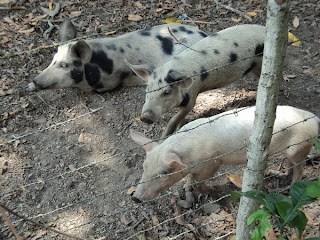I just finished playing an unsuccessful round of the classic Peace Corps game: "Identify what's crawling around near your bed at the wee hours of the morning" (as a side note, this game is way more fun when you have a mosquito net. I love my mosquito net. It also protects against malaria, which is the #1 killer of humans. Seriously, mosquito nets are really awesome).
Since the roosters and I were already up, I decided to do another blog post, and I think it's time to make use of all the food pictures I've been taking. Here's Dominican cuisine 101:
I'm not a picky eater, and I've been pretty content with everything they've given me here. If there's any problem, it's that my host families give me way too much, and I don't want to offend them by not eating it all. When I don't finish everything, I can honestly tell them that it's not because the food tasted bad. That said, there's a reason there aren't many Dominican restaurants in the US...the food may not be bad, but it's not very exciting.
The foundation of Dominican food are the viveres, which are the general term for starchy vegetables. Besides potatoes and bananas, they have yuca, batata, ñame, plantain, and several others that I can't remember, pronounce, or spell. I doubt there's an English word for many of them. They all look something like either a potato or a banana, and they all have their own flavor, although (like potatoes) that flavor ususally isn't very strong. The viveres are either boiled and served in large pieces, or made into a mashed-potato-like dish called mangu.
Meat is widely available. Chickens are running all over the place, so chicken and eggs are pretty cheap. Beef and pork are also pretty easy to come by. Fish is plentiful, especially near the coasts, but the local fish often eat a certain algae that makes them toxic, so PC volunteers are told to stay away from locally caught fish.
Salami is a major staple, which surprised me. Apparently, a lot of Jews came to the country during WWII and started the salami industry, which has been a huge success. I've had more salami in the last month than the rest of my life put together. Who'd a thunk.
The DR earned its place on the map as a sugar producer, and that remains one of it's major crops. They add a lot of sugar to a lot of things. It can be good, but it can be overdone.
Rice and beans are another major part of the diet. If you go to a Dominican restaurant and order 'la banders' (the flag), you'll get rice and beans (and probably salami).
The favorite Dominican dessert (served now, during lent) made of sweetened beans. Basically, they cook beans and viveres and add a bunch of sugar. It tastes something like Life cereal, with beans added. It's not bad, but the flavors aren't things that I would put together.
Finally, there's fruit. I love fruit, and the huge variety on this tropical island deserves its own post. As with the viveres, most of the fruit here has been new to me, but it's all grown locally, which makes it way tastier than anything you get in a grocery store in the States.
And now, pictures of some of the meals I've had over the last month:
 |
| Boiled plantains. I thought the dish at the front was eggs, but it turned out to be fried cheese, which is a fairly common item. |
 |
| Mangu and salami. |
 |
| Yuca and salami. |
|
 |
| Fried cheese, something banana-like, and avacado (which my host family told me is pronounced 'guacamole' in Mexico). |
|
 |
| Some bread, some fruit, and a bowl of soup that my host mom almost didn't serve me because it was 'too spicy.' For the record, Mexicans are the ones who eat spicy food, not Dominicans. The soup wasn't very spicy, but it would have scared away the average Dominican. |
|
 |
| Fruit and sandwiches (with cheese and salami). |
 |
| Mangu with cheese and onions. I don't know which vegetable this mangu was made from, but the cheese and onions made it really tasty. |
|
 |
| Rice, beans, chicken, and a salad. This was lunch, which is the biggest meal of the day for Dominicans. |
|
 |
| This is a breakfast dish based on flour which is a lot like outmeal. They add a lot of sugar, so it's really sweet. |
 |
| Another lunch, with fish instead of chicken. My host mom buys fish that don't swim in the Caribbean, so we know they don't have the local toxin. |
 |
| Spaghetti with fritos (fried plantains). |
 |
| Ñame, platanos, and something with salami. |
 |
| Breakfast with papaya, also known as "nature's laxitive." |
 |
| Mangu with salami and onions. |
 |
| Bollos (dumplings) with ñame. Bollos are tasty. |
 |
| Chicken, batata, and ñame blanco. |
 |
| Habichuelas con dulce. |
 |
| More habichuelas con dulce. |



































